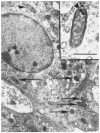Fc-dependent polyclonal antibodies and antibodies to outer membrane proteins A and B, but not to lipopolysaccharide, protect SCID mice against fatal Rickettsia conorii infection
- PMID: 15039346
- PMCID: PMC375156
- DOI: 10.1128/IAI.72.4.2222-2228.2004
Fc-dependent polyclonal antibodies and antibodies to outer membrane proteins A and B, but not to lipopolysaccharide, protect SCID mice against fatal Rickettsia conorii infection
Abstract
An emphasis on cellular immunity against Rickettsia has led to neglect of analysis of the role of antibody. The availability of an excellent mouse model of spotted fever rickettsiosis enabled investigation of a potential role of antibody in immunity to Rickettsia conorii. C3H severe combined immunodeficiency (SCID) mice were passively transfused with monoclonal antibodies against rickettsial outer membrane protein A (OmpA), OmpB, or lipopolysaccharide (LPS), polyclonal anti-R. conorii serum, Fab fragments of polyclonal antiserum, or no antibodies and then challenged 48 h later with 10 50% lethal doses (LD(50)) of R. conorii. All mice that received monoclonal antibodies against OmpA and two of four mice that received monoclonal antibodies against OmpB or polyclonal antisera were completely protected, but the recipients of anti-LPS antibodies or the Fab fragments were not protected. Polyclonal antibody treatment of C3H SCID mice that had been infected with 10 LD(50) of R. conorii 4 or 5 days earlier prolonged the life of the infected mice from 10.4 to 22.5 days and resulted in decreased levels of infectious rickettsiae in the spleen and liver 24 and 48 h later. Treatment with protective antibodies resulted in the development of large aggregates of R. conorii antigens in splenic macrophages and intraphagolysosomal rickettsial death and digestion. The kinetics of development of antibodies to R. conorii determined by immunoblotting revealed antibodies to LPS on day 6 and antibodies to OmpA and OmpB on day 12, when recovery from the infection had already occurred. Antibodies to particular epitopes of OmpA and OmpB may protect against reinfection, but they may not play a key role in immunity against primary infection. Antibodies might be useful for treating infections with antibiotic-resistant organisms, and some B-cell epitopes should be included in a subunit vaccine.
Figures




References
-
- Anacker, R. L., R. H. List, R. E. Mann, S. F. Hayes, and L. A. Thomas. 1985. Characterization of monoclonal antibodies protecting mice against Rickettsia rickettsii. J. Infect. Dis. 151:1052-1060. - PubMed
-
- Billings, A. N., H.-M. Feng, J. P. Olano, and D. H. Walker. 2001. Rickettsial infection in murine models activates an early anti-rickettsial effect mediated by NK cells and associated with production of gamma interferon. Am. J. Trop. Med. Hyg. 65:52-56. - PubMed
-
- Brieland, J. K., L. A. Heath, G. B. Huffnagle, D. G. Remick, M. S. McClain, M. C. Hurley, R. K. Kunkel, J. C. Fantone, and C. Engleberg. 1996. Humoral immunity and regulation of intrapulmonary growth of Legionella pneumophila in the immunocompetent host. J. Immunol. 157:5002-5008. - PubMed
-
- Cloeckaert, A., I. Jacques, P. de Wergifosse, G. Dubray, and J. N. Limet. 1992. Protection against Brucella melitensis or Brucella abortus in mice with immunoglobulin G (IgG), IgA, and IgM monoclonal antibodies specific for a common epitope shared by the Brucella A and M smooth lipopolysaccharides. Infect. Immun. 60:312-315. - PMC - PubMed
-
- Edelson, B. T., P. Cossart, and E. R. Unanue. 1999. Cutting edge: paradigm revisted: antibody provides resistance to Listeria infection. J. Immunol. 163:4087-4090. - PubMed
Publication types
MeSH terms
Substances
Grants and funding
LinkOut - more resources
Full Text Sources
Molecular Biology Databases
Research Materials

